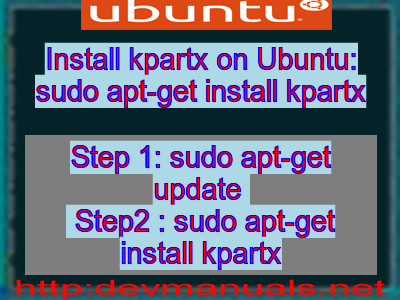- Active Oldest Votes. Partx asks the kernel to probe a given device and re-read the partition table. The kernel is doing the work here. Kpartx creates device mapper entries and so can be used by devices that the kernel does not natively support partitioning, such as multipath device mapper devices ('kpartx' is part of multipath-tools) or files.
- Don't return until the partitions are created EXAMPLE To mount all the partitions in a raw disk image: kpartx -av disk.img This will output lines such as: loop3p1: 0 20964762 /dev/loop3 63 The loop3p1 is the name of a device file under /dev/mapper which you can use to access the partition, for example to fsck it: fsck /dev/mapper/loop3p1 When.
Objective
This article describes how to mount a Linux Logical Volume Manager (LVM) partition located inside a virtual disk (VDI) in a XenServer Host.


If a Linux Virtual Machine (VM) with an LVM partition crashes, then the LVM partition cannot be accessed directly with kpartx. Red Hat Enterprise Linux (RHEL) 5 by default uses LVM for installing the root partition.
Instructions
To mount a Linux Logical Volume Manager (LVM) partition, complete the following procedure:
Check for the universal unique identifier (UUID) of the virtual machine using the following commands:
Note: You will need the VDI-UUID later as this is the disk which has the LVM partition or partitions.
# xe vm-list name-label=<vm-name>
# xe vm-disk-list uuid=<vm-uuid>Run kpartx command to create loop devices for the partitions inside the Logical volume.
Find out the LV volume file that is related to the particular VDI listed in the previous step:
# xe sr-list type=lvmAutodesk autocad 2017 _osx_r1.dmg. Use the SR-UUID where the VDI is located to find out the volume group (VG) and activate all LVs in that group:
# vgchange –ay VG_XenStorage-<sr-uuid>List all disks in that VG group:
# ll /dev/VG_XenStorage-<sr-uuid>Map the LV using the kpartx command. This is the VDI disk of the particular virtual machine:
# kpartx –a /dev/VG_XenStorage-<sr-uuid>/LV-<vdi-uuid>Grand theft auto v. Check the mapped partitions in /dev/mapper to validate LV-<vdi-uuid>p<partition_number>.
For example:
# ll /dev/mapper# LV-c4d1f0af-b0c4-413c-8832-2c1bfd90d118p1
# LV-c4d1f0af-b0c4-413c-8832-2c1bfd90d118p2

The following command scans partitions for LVM and adds this new volume group to the XenServer Host. Run the following command to see the VG name related to /dev/mapper:
# pvscan
Kpartx - Create device maps from partition tables Synopsis kpartx -a -d -l -v wholedisk Description This tool, derived from util-linux' partx, reads partition tables on specified device and create device maps over partitions segments detected. It is called from hotplug upon device maps creation and deletion. Options-a Add partition.
Run the following command to see all VGs name inside the virtual machine:
For example:
# vgscanIf the VG inside the virtual machine was named as system, should see a similar row:
# Found volume group “system” using metadata type lvm2
Use the following commands to make all logical volumes in the group active:
# lvchange -ay <vg-name>
(same VG name from the previous command)
For example:
# lvchange –ay system
Verify the volume group has active logical volumes listed as follows:
A similar output appears to include VG system with two partitions:
# lvscan# ACTIVE ‘/dev/system/root’ [7.43 GB] inherit
# ACTIVE ‘/dev/system/swap’ [512.00 MB] inherit
Create a directory, mount this logical volume, and access its data using the following commands:
# mkdir /mnt/partition
# mount /dev/<vg-name>/<partition> /mnt/partition
# cd /mnt/partition
# ls
Reverse Procedure
To unmount a mounted devise, complete the following procedure:
Run the following command to unmount mounted devices:
# umount /mnt/disk

Deactivate the logical volumes on the VG:
# vgchange –an <VG-name>
Delete partition mappings with kpartx:
# kpartx –d /dev/ VG_XenStorage-<sr-uuid>/LV-<vdi-uuid>
This is similar to the previous command except for the option which has changed from “-a” to “-d”Note: Deactivate all LV in the group, otherwise the command will fail.
Additional Resources
To prevent file system errors, use check disk before mounting the partition (before proceeding with step 9). This applies only to EXT3 file systems:
# fsck.ext3/dev/<vg-name>/<partition>
Kpartx Ubuntu
For example: # fsck.ext3 /dev/system/root



